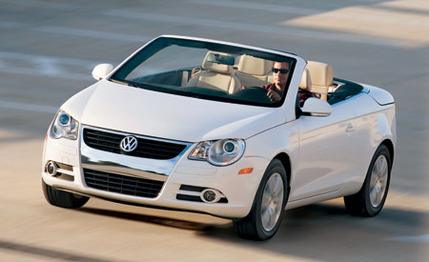
 Road Test
Road Test
Hard-roof convertibles have gone from rarity to novelty to commodity in a half-dozen years. The robotic roof fold-down no longer grabs headlines. Now the question is: How clever is the convertible?
In the case of the VW Eos, newly born into the just-under-$30K neighborhood, we're saying "pretty darn slick." That appraisal applies to the everyday realities of a convertible: shakes and rattles, wind noise, passenger room, and trunk space when the top is stowed.
As a runabout for the passionate driver, we'll give the Eos only a "fair."
Most buyers will have no performance complaints. The 200-hp, 2.0-liter turbo four rolls up to 60 mph in 6.9 seconds, clearing the quarter-mile in 15.4 seconds at 92 mph. Road grip is more than decent at 0.83 g. The brakes, too, are creditable, stopping from 70 mph in 176 feet. This is an EZ driver. The steering is quick, the roll angles are tightly controlled, and with its compact dimensions — just under 174 inches in overall length, about six inches shorter than a VW Jetta — the Eos darts like a minnow among the whales of metro traffic.
Over disrupted surfaces, the suspension rebounds hard. Road impacts are fairly quiet, however, which makes the ride seem more luxurious than it is. And the body structure is first-rate — you'll feel very little shake, top up or top down.
The passionate driver will be less satisfied. The steering accuracy melts into numb understeer as you approach the limit. The brakes always have a queasy feel.
Although we prefer the standard-equipment six-speed manual gearbox, the test car had the automatic DSG six-speed. Steering-wheel shift paddles at three and nine are optional. The test car responded quickly to manumatic gear-lever flicks. At the same time, it's a weird automatic, inclined to be snatchy at launch. And it lets the car roll easily when you're stopped on an incline and take your foot off the brake. We understand that it's a manual gearbox with a pair of disc clutches, and that it is being driven by a computer, so we make allowances. You might think it's just a snatchy automatic.
The Eos is an unusual convertible in that it's exceptionally pleasing with the top up, thanks to a huge, standard-equipment sunroof that makes the interior bright and airy. Instead of the customary small island of glass well away from the roof's edges, the Eos glass is wide and situated at the forward edge of the movable roof. It slides tight against the windshield frame to close and retracts up and over the hard roof in the open position. When it's time to drop the top, the retracted glass nests with other similarly curved roof sections, like spoons in the drawer, and disappears under the trunklid, which also serves as a boot cover.
The disappearing act takes 27 seconds, not counting the time required to open or close the side windows, and it's fully automatic, even the unlatching from the windshield frame. Watch out behind, however; a space of two feet beyond the rear bumper is necessary to clear the decklid as it swings back to swallow the roof. If you opt for the parking-distance sensor, it will warn you when space is too tight. Without that option, the eyes in the back of your head must assume responsibility.
Hardtop convertibles almost always shrink trunk space more than softtops do when the roof is stowed. So vacation trippers hoping for simultaneous sun and luggage schlepping probably want a softtop or should resign themselves to hauling bags in the rear seat. That said, the Eos is quite good at preserving cargo room; in the open-air mode it retains 7 of the original 11 cubic feet. Volvo's C70 convertible is similarly successful at a much higher price. Pontiac's G6 convertible, stickered near the Eos, fares poorly by comparison.